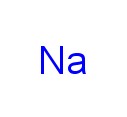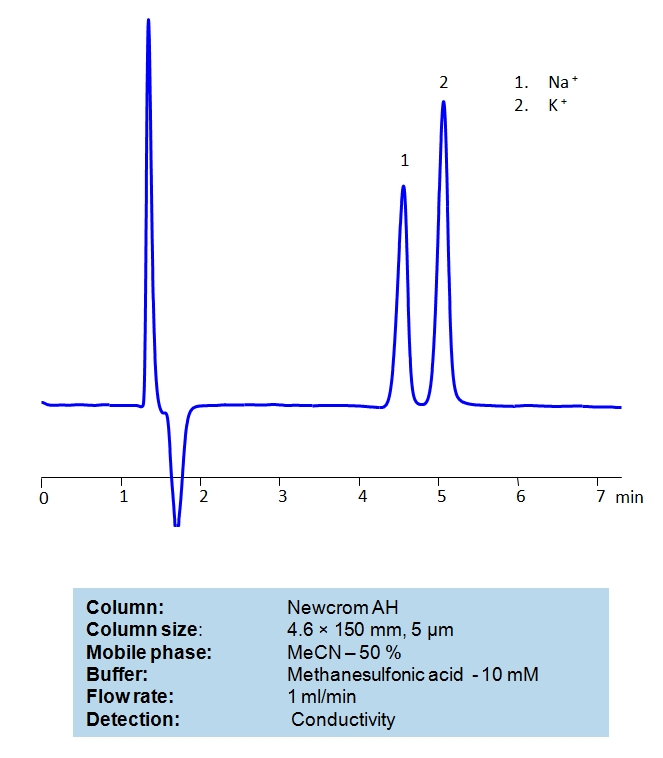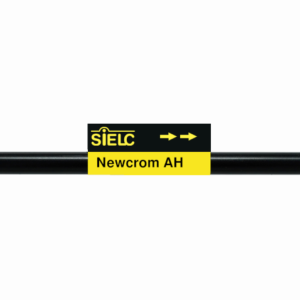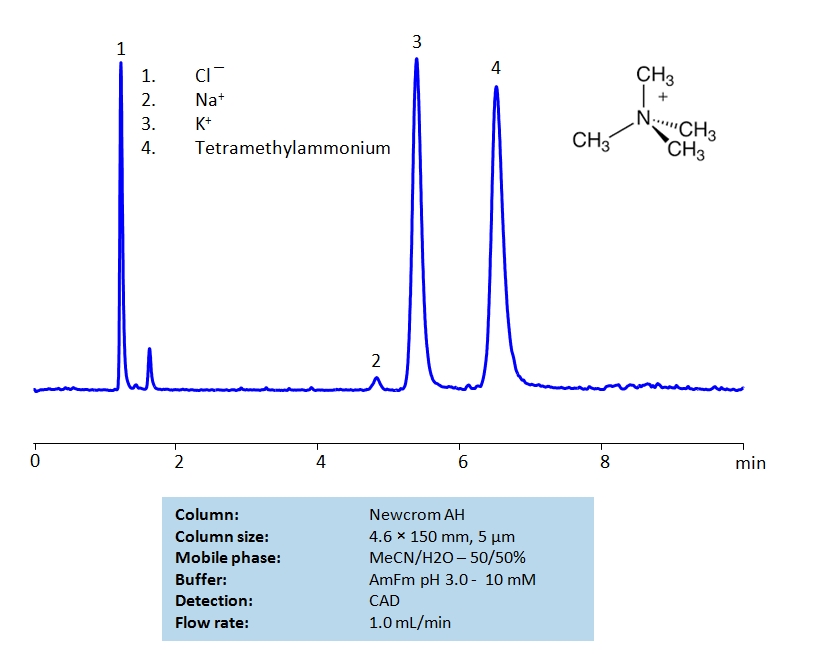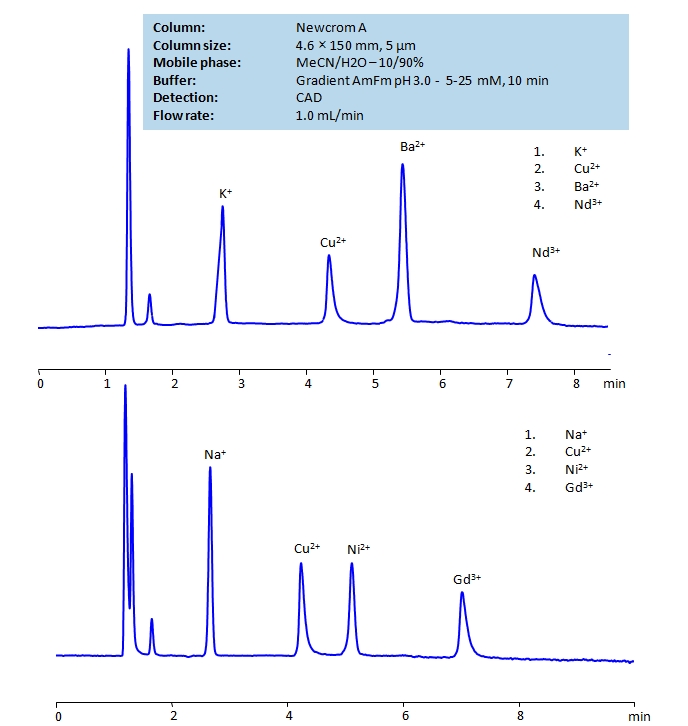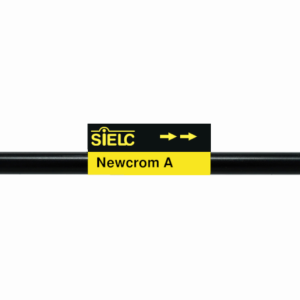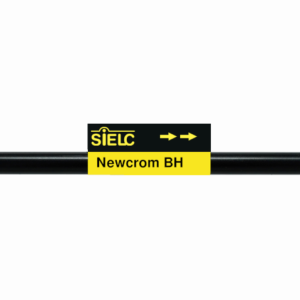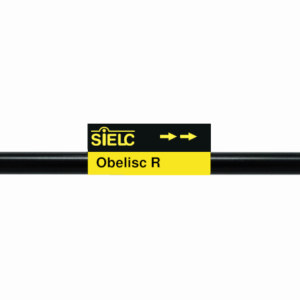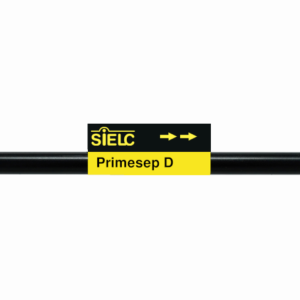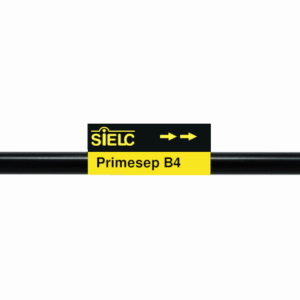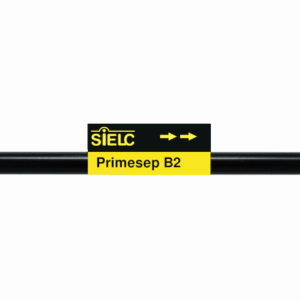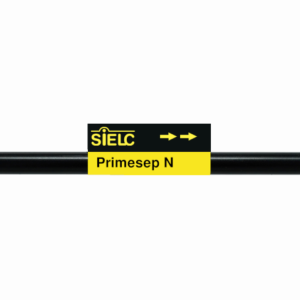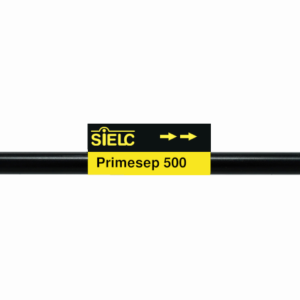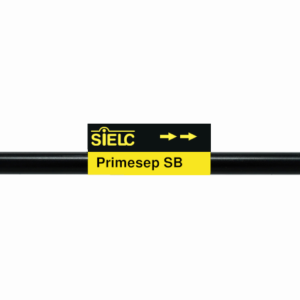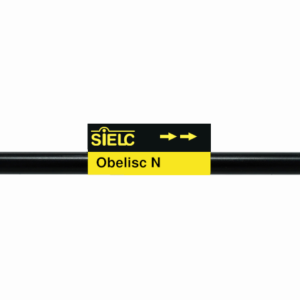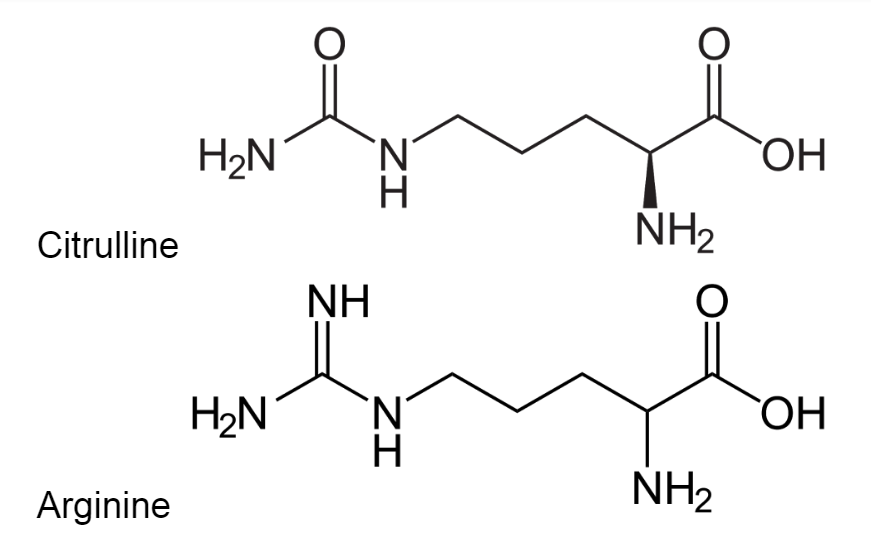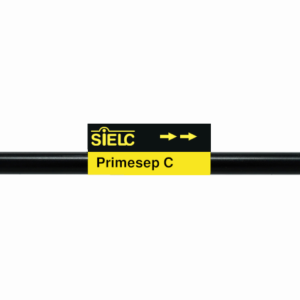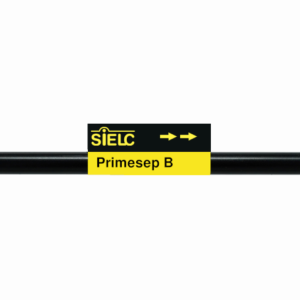| CAS Number | 7440-23-5 |
|---|---|
| Molecular Formula | Na |
| Molecular Weight | 22.990 |
| InChI Key | MPMYQQHEHYDOCL-UHFFFAOYSA-N |
| Synonyms |
|
Applications:
HPLC Method for Separation of Sodium, Potassium, Lithium, and Ammonium on Primesep 100 Column
August 7, 2024
High Performance Liquid Chromatography (HPLC) Method for Analysis of Ammonium Ion, Lithium, Potassium, Sodium on Primesep 100 by SIELC Technologies
Separation type: Liquid Chromatography Mixed-mode
High Performance Liquid Chromatography (HPLC) Method for Analysis of Ammonium Ion, Lithium, Potassium, Sodium
Inorganic cations and ammonia are usually analyzed by ion-exchange chromatography with a conductivity detector. Mixed-mode chromatography achieves the same goal with an ELSD detector. In addition to retaining ions, mixed-mode column can retain hydrophobic molecules also, making it possible to analyze a wide variety of ionic and non-ionic compounds in one run. In this method sodium, potassium, and lithium ions were separated along with ammonium ions on a Primesep 100 column. Detection technique is ELSD.
| Column | Primesep 100, 4.6 x 250 mm, 5 µm, 100 A, dual ended |
| Mobile Phase | MeCN/H2O – 80/20% |
| Buffer | TFA – 0.1% |
| Flow Rate | 1.0 ml/min |
| Detection | ELSD, the nebulizer and evaporator temperatures 50°C, with a gas flow rate of 1.6 Standard Liters per Minute (SLM) |
| Class of Compounds | Ions, Hydrophilic, Ionizable, Vitamin, Supplements |
| Analyzing Compounds | Sodium, Potassium, Lithium, Ammonium |
Application Column
Primesep 100
Column Diameter: 4.6 mm
Column Length: 250 mm
Particle Size: 5 µm
Pore Size: 100 A
Column options: dual ended
Lithium
Potassium
Sodium

Separation of Sodium and Potassium Ions on Newcrom AH Column
October 21, 2020
HPLC Method for Sodium, Potassium on Newcrom AH by SIELC Technologies
Sodium Ions, Na+, are crucial for regulating fluid balance, transporting nutrients, and generating electrical signals within a body.
Potassium ions, K+, are essential for cell function. They work as charge carriers inside animal cells to create the membrane. Imbalance of potassium can lead to debilitating health problems, but consumption of it through a diet can help regulate the negative effects of sodium on blood flow.
Sodium and potassium ions can be separated on a mixed-mode Newcrom AH column with a simple isocratic mobile phase of water, acetonitrile (ACN) and methanesulfonic acid. It can be detected using a conductivity detector.
| Column | Newcrom AH, 4.6 x 150 mm, 5 µm, 100 A, dual ended |
| Mobile Phase | MeCN/H2O – 50/50% |
| Buffer | Methanesulfonic acid – 10 mM |
| Flow Rate | 1.0 ml/min |
| Detection | Conductivity |
| Class of Compounds | Hydrophilic, Metal, Ion |
| Analyzing Compounds | Sodium, Potassium |
Application Column
Newcrom AH
Column Diameter: 4.6 mm
Column Length: 150 mm
Particle Size: 5 µm
Pore Size: 100 A
Column options: dual ended
Sodium

HPLC Separation of Sodium, Potassium Ions and Tetramethylammonium Chloride on Newcrom AH Column
September 8, 2020
HPLC Method for Analysis of Tetramethylammonium, Sodium, Potassium on Newcrom AH by SIELC Technologies
High Performance Liquid Chromatography (HPLC) Method for Analysis of Tetramethylammonium, Sodium, Potassium.
Tetramethylammonium chloride is a quaternary ammonium salt used widely as a reagent in industrial applications. It can be separated from sodium and potassium chlorides on a mixed-mode Newcrom AH column with a simple isocratic MS-compatible mobile phase of water, acetonitrile (ACN) and ammonium formate (AmFm) buffer.
| Column | Newcrom AH, 4.6 x 150 mm, 5 µm, 100 A, dual ended |
| Mobile Phase | MeCN/H2O – 50/50% |
| Buffer | AmFm pH 3.0- 10 mM |
| Flow Rate | 1.0 ml/min |
| Detection | CAD (Corona) MS- compatible mobile phase |
| Class of Compounds | Hydrophilic, Metal, Ion, Quaternary ammonium salt |
| Analyzing Compounds | Tetramethylammonium, Sodium, Potassium |
Application Column
Newcrom AH
Column Diameter: 4.6 mm
Column Length: 150 mm
Particle Size: 5 µm
Pore Size: 100 A
Column options: dual ended
Sodium
Tetramethylammonium

HPLC Determination of Ions on Newcrom A Column
March 24, 2020
HPLC Method for Sodium, Copper, Nickel, Gadolinium acetate, Barium, Neodymium, Copper Sulfate on Newcrom A by SIELC Technologies
High Performance Liquid Chromatography (HPLC) Method for Analysis of Sodium, Copper, Nickel, Gadolinium acetate, Barium, Neodymium, Copper Sulfate.
Potassium ions, K+, are essential for cell function. They work as charge carriers inside animal cells to create the membrane. Imbalance of potassium can lead to debilitating health problems, but consumption of it through a diet can help regulate the negative effects of sodium on blood flow.
Copper ions, Cu2+, are known for their excellent electrical and thermal conductivity. Copper has been used since ancient times for tools, coins, and plumbing. These days, it is typically used in electrical wiring, construction, and industrial machinery. Timelessly, it plays a vital role in enzymes and red blood cell formation.
Barium ions, Ba2+, are typically used in quantum computing with trapped-ion computers, serving as a stable platform for qubits. It’s other uses include ceramics, medical imaging as a contrast agent in X-ray and CT scans, and in experimental physics for beta decay process.
Neodymium ions, Nd3+, have a variety of uses including glass, lasers, and promoting plant growth. Most notably, Neodymium magnets are the strongest permanent magnets known. They can lift a thousand times its own weight and snap together with enough force t break bones. The major drawback of Neodymium magnets is that they lose their magnetism at low temperatures.
Sodium ions, which have a chemical symbol of Na+, are a soft alkali and highly reactive metal. Sodium is found in abundance in everyday materials like table salt, sea water, and even the Earth’s crust. It is crucial for the body’s function and fluid balance.
Nickel ions, Ni2+, are considered the most common and stable oxidation state for nickel, which is a lustrous metal. In this state, it forms compounds easily with all common anions. Ni2+ is often found as green hexahydrate.
Gadolinium ions, Gd3+, have a variety of uses. Due to Gadolinium’s high neutron cross-section, it is effective in neutron radiography and in shielding of nuclear reactors. It is also used as an MRI contrasting agent, in experiments to study calcium channels, and fuel.
Sodium, Copper, Nickel, Gadolinium acetate, Barium, Neodymium, Copper Sulfate can be retained and analyzed using the Newcrom A stationary phase column. The analysis utilizes an isocratic method with a simple mobile phase consisting of water and acetonitrile (MeCN) with an ammonium formate buffer. Detection is performed using CAD.
| Column | Newcrom A, 4.6 x 150 mm, 5 µm, 100 A, dual ended |
| Mobile Phase | MeCN – 10% |
| Buffer | Gradient Ammonium formate pH 3.0 |
| Flow Rate | 1.0 ml/min |
| Detection | CAD |
| Class of Compounds | Hydrophilic, Metal, Ion |
| Analyzing Compounds | Sodium, Copper, Nickel, Gadolinium acetate, Barium, Neodymium, Copper Sulfate |
Application Column
Newcrom A
Column Diameter: 4.6 mm
Column Length: 150 mm
Particle Size: 5 µm
Pore Size: 100 A
Column options: dual ended
Copper
Copper Sulfate
Gadolinium acetate
Neodymium
Nickel
Sodium

HPLC Separation of Inorganic Anions on Newcrom BH Column
October 23, 2019
HPLC Method for Sodium, Phosphate, Chloride, Bromide, Nitrate, Sulfate, Iodine, Perchlorate, Iodide on Newcrom BH by SIELC Technologies
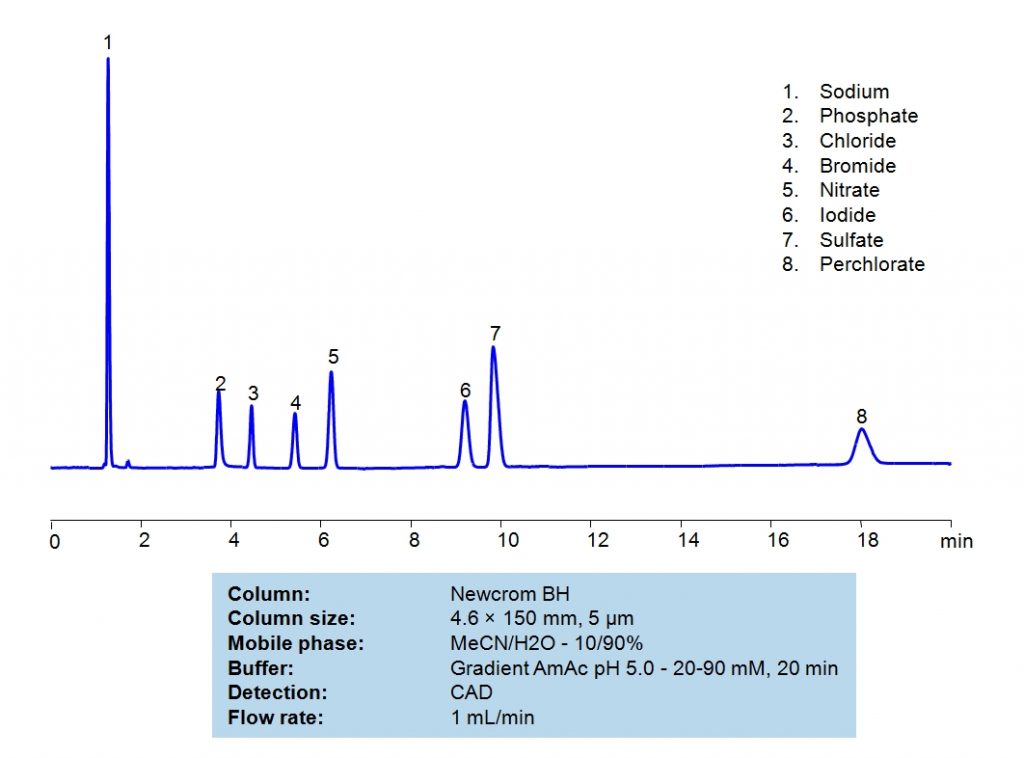
High Performance Liquid Chromatography (HPLC) Method for Analysis of Sodium, Phosphate, Chloride, Bromide, Nitrate, Sulfate, Iodine, Perchlorate, Iodide
Sodium, which has a chemical symbol of Na, is a soft alkali metal that is highly reactive. It is found in abundance in everyday materials like table salt, sea water, and even the Earth’s crust. It is crucial for the body’s function and fluid balance.
Phosphate, PO43-, is a compound that plays an important part in biological energy transfer. It contains phosphorus, which is also a key component in bones and teeth. It is also a buffer, which helps maintain pH levels in a body.
Chloride is typically used to refer to a compound or molecule that contains a chlorine anion: Cl–. It is an electrolyte that is essential for bodily functions including blood pH, fluid balance, cellular functions, and more. Imbalance of chloride can indicate underlying health problems.
Bromide is typically used to refer to a compound or molecule that contains a bromide anion: Br–. It is often found in anticonvulsants, flame-retardant materials, and cell stains.
Nitrate, NO3–, is a compound of nitrogen and oxygen. It is essential as a nutrient in plants; therefore, it is often used in fertilizers. It is easily found in leafy greens. While it is important for cardiovascular health, too high of exposure to it can be dangerous.
Iodide, the Ionic form of Iodine, I– is essential for thyroid hormone production. Lack of it can lead to iodine deficiency disorders. It is typically found in Iodized salt and occasionally as an antiseptic.
Sulfate is an ionic chemical with the formula SO42-. In nature, it is usually found in geodes like gypsum. It is also created in atmosphere from sulfur dioxide. It is used for a variety of applications, but most notably, coloring wood and creating light-reflecting paints.
Perchlorate is an inorganic compound with the formula ClO4–. It is most typically used for explosives. For example, fireworks and rocket propellants. Due to it’s water solubility, it can easily contaminate it. When ingested, it can pose a health risk and cause developmental harm.
Sodium, Phosphate, Chloride, Bromide, Nitrate, Sulfate, Iodine, Perchlorate, Iodide can be retained and analyzed using the Newcrom BH stationary phase column. The analysis utilizes an isocratic method with a simple mobile phase consisting of water and acetonitrile (MeCN) with a Ammonium Acetate buffer. Detection is performed using CAD.
| Column | Newcrom BH, 4.6 x 150 mm, 5 µm, 100 A, dual ended |
| Mobile Phase | MeCN/H2O – 10/90% |
| Buffer | Gradient AmAc pH 5.0 – 20-90 mM , 20 min |
| Flow Rate | 1.0 ml/min |
| Detection | CAD (Corona) (MS-compatible mobile phase) |
Application Column
Newcrom BH
Column Diameter: 4.6 mm
Column Length: 150 mm
Particle Size: 5 µm
Pore Size: 100 A
Column options: dual ended
Chloride
Iodide
Iodine
Nitrate
Perchlorate
Phosphate
Sodium
Sulfate

Separation of Chlorate, Perchlorate, and Phosphonate Ions on Obelisc R Column
July 30, 2015
HPLC Method for Chlorate, Perchlorate, Phosphonate, Sodium on Obelisc R by SIELC Technologies
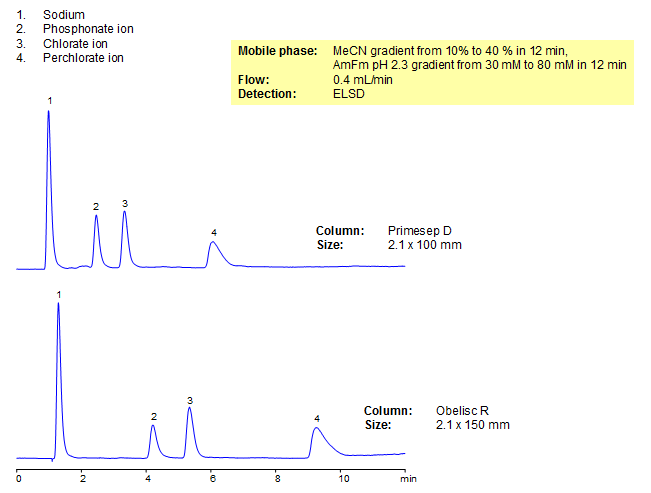
High Performance Liquid Chromatography (HPLC) Method for Analysis of Chlorate, Perchlorate, Phosphonate, Sodium.
The ionic forms of Chlorate, Perchlorate, and Phosphonates are useful in many industries including medicine, paper and use in explosives. Due to their lack of UV activity, an ELSD was used to detect both the anions and cations of all three sodium salts. The ions were retained on both Primesep D and Obelisc R columns. Primesep D is a reverse phase column with embedded basic ion-pairing groups. Obelisc R is also a reverse phase column, but can be additionally tuned due to embedded ionic groups and a hydrophobic chain.
| Column | Obelisc R, 2.1 x 50 mm, 5 µm, 100 A, dual ended |
| Mobile Phase | Gradient MeCN – 10-40%, 12 min |
| Buffer | Gradient AmFm pH 2.3- 30-80 mM, 12 min |
| Flow Rate | 0.4 ml/min |
| Detection | ELSD |
| Class of Compounds |
Hydrophilic, Ionizable |
| Analyzing Compounds | Chlorate, Perchlorate, Phosphonate, Sodium |
Application Column
Obelisc R
Column Diameter: 2.1 mm
Column Length: 50 mm
Particle Size: 5 µm
Pore Size: 100 A
Column options: dual ended
Perchlorate
Phosphonate
Sodium

Separation of Paraquat, Diguat, and Glyphosate on Obelisc R Column
July 3, 2013
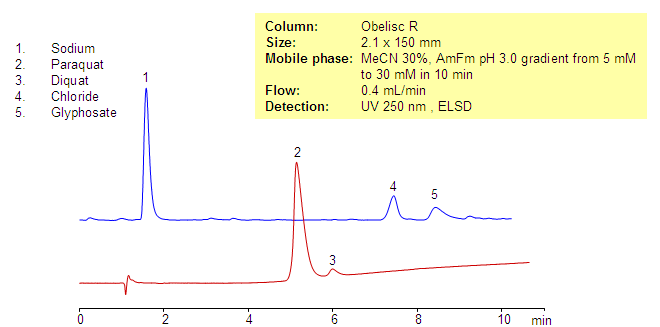
Paraquat, diquat and glyphosate are three of most widely used herbicides in the world. Paraquat and diquat are very polar and very basic quaternary amines. Glyphosate is an aminophosphonic analog of glycine. It is very polar and acidic at most of the pH of the mobile phase. Since glyphosate and the quats have opposite charges no ion-pairing method can be developed for the mixture of basic and acidic herbicides. All three herbicides were separated on the Obelisc R tri-modal column. Paraquat and diquat are retained by a cation-exchange mechanism, and glyphosate is retained by weak reversed-phase and strong anion-exchange mechanisms. This method can be used for analysis of common herbicides in fruits, vegetables, ground water, drinking water and other matrices. Method is LC/MS compatible and can be used to determine trace levels of herbicides.
| Column | Obelisc R, 2.1×150 mm, 5 µm, 100A |
| Mobile Phase | MeCN – 30% |
| Buffer | Gradient AmFm pH 3.0 – 5-30 mM, 10 min |
| Flow Rate | 0.4 ml/min |
| Detection | UV, 250 nm, ELSD |
| Class of Compounds |
Insecticide, Herbicide, Fungicide, Hydrophobic, Ionizable |
| Analyzing Compounds | Paraquat, Diquat, Glyphosate |
Application Column
Obelisc R
SIELC has developed the Obelisc™ columns, which are mixed-mode and utilize Liquid Separation Cell technology (LiSC™). These cost-effective columns are the first of their kind to be commercially available and can replace multiple HPLC columns, including reversed-phase (RP), AQ-type reversed-phase, polar-embedded group RP columns, normal-phase, cation-exchange, anion-exchange, ion-exclusion, and HILIC (Hydrophilic Interaction Liquid Chromatography) columns. By controlling just three orthogonal method parameters - buffer concentration, buffer pH, and organic modifier concentration - users can adjust the column properties with pinpoint precision to separate complex mixtures.
Select optionsDiquat
Glyphosate
Paraquat
Sodium
UV Detection

Separation of Compounds in TCA Cycle on Primesep D Column
July 3, 2013
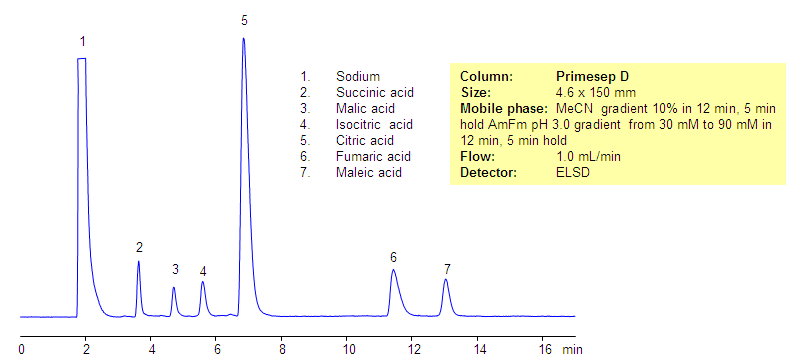
The citric acid cycle (tricarboxylic acid cycle, Krebs cycle) is a key process in the metabolic pathway by which all aerobic organisms generate energy. Compounds generated during TCA are hydrophilic, acidic compounds. Some of the hydrophilic acids are very strong while others are relatively weaker. All compounds have very low hydrophobicity and do not retain by the reversed-phase mechanism on the C18 or C8 HPLC columns. Citric acid and related products were separated in reversed-phase, anion-exchange mode on the Primesep D mixed-mode column. All hydrophilic, acidic compounds are well separated and demonstrate good shape. This robust method can be used for analysis of components of the TCA cycle and other highly hydrophilic compounds. This method is fully compatible with LC/MS and prep chromatography.
| Column | Primesep D, 4.6×150 mm, 5 µm, 100A |
| Mobile Phase | MeCN/H2O |
| Buffer | AmFm, pH 3.0 |
| Flow Rate | 1.0 ml/min |
| Detection | ELSD |
| Class of Compounds |
Acid, Hydrophilic, Ionizable |
| Analyzing Compounds | Sodium, Succinic acid, Malic acid, Isocitric acid, Citric acid, Fumaric acid, Maleic acid |
Application Column
Primesep D
The Primesep family of mixed-mode columns offers a wide variety of stationary phases, boasting unprecedented selectivity in the separation of a broad array of chemical compounds across multiple applications. Corresponding Primesep guard columns, available with all stationary phases, do not require holders. SIELC provides a method development service available to all customers. Inquire about our specially-tailored custom LC-phases for specific separations.
Select optionsFumaric Acid
Isocitric Acid
Maleic Acid
Malic Acid
Sodium
Succinic Acid

The Separation of Sodium, Dioctylsulfosuccinic Acid, and Sulfosuccinic Acid
July 2, 2013
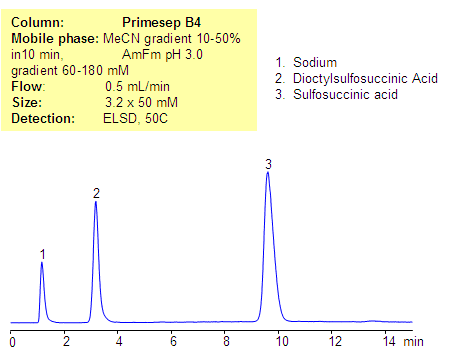
Sulfosuccinic acid and the corresponding dioctyl ester were separated on the Primesep B4 short carbon-chain anion-exchange column. Short carbon chain stationary phase allows to elute hydrophobic and acidic diester in reasonable time. No elution was observed on the mixed-mode columns with longer carbon chain analogs due to very strong hydrophobic and anion-exchange interaction.
| Column | Primesep B4, 3.2×50 mm, 5 µm, 100A |
| Mobile Phase | Gradient MeCN – 10 -50%, 10 min |
| Buffer | Gradient AmFm pH 3.0- 60-180 mM, 10 min |
| Flow Rate | 1.0 ml/min |
| Detection | ELSD, 50C |
| Class of Compounds |
Acid, Hydrophilic, Ionizable |
| Analyzing Compounds | Sodium, Dioctyl Sulfosuccinic acid, Sodium Docusate |
Application Column
Primesep B4
The Primesep family of mixed-mode columns offers a wide variety of stationary phases, boasting unprecedented selectivity in the separation of a broad array of chemical compounds across multiple applications. Corresponding Primesep guard columns, available with all stationary phases, do not require holders. SIELC provides a method development service available to all customers. Inquire about our specially-tailored custom LC-phases for specific separations.
Select optionsSodium
Sulfosuccinic acid

HPLC Separation of Sodium, Dioctyl Sulfosuccinic Acid, and Sulfosuccinic Acid
July 10, 2012

Application Notes: Dioctyl sodium sulfosuccinate is a common component of consumer products and medications. It is also used as emulsifier, wetting, and dispersing agent. It is a highly acidic, and hydrophobic compound. It serves as a starting material for dioctyl sodium sulfonate. Both compounds were retained and separated on Primesep B4 mixed-mode reversed-phase anion-exchange column. The primesep B4 column has C4 carbon chain and it is much less hydrophobic than Primesep D or Primesep B2 column. The low hydrophobicity of the stationary phase is strong enough to provide reversed-phase retention for dioctyl sulfosuccinic acid. This method can be used for quantification of these two compounds in reaction mixtures and formulation. The method is LC/MS and ELSD/CAD compatible.
Application Columns: Primesep B4
Application compounds: Sodium, Dioctyl Sulfosuccinic Acid, Sulfosuccinic Acid
Detection technique: LC/MS, ELSD/CAD
| Column | Primesep B4, 3.2×50 mm, 5 µm, 100A |
| Mobile Phase | Gradient MeCN – 10 -50%, 10 min |
| Buffer | Gradient AmFm pH 3.0- 60-180 mM, 10 min |
| Flow Rate | 1.0 ml/min |
| Detection | ELSD |
| Class of Compounds |
Acid, Hydrophilic, Ionizable |
| Analyzing Compounds | Sodium, Dioctyl Sulfosuccinic Acid, Sulfosuccinic Acid |
Application Column
Primesep B2
The Primesep family of mixed-mode columns offers a wide variety of stationary phases, boasting unprecedented selectivity in the separation of a broad array of chemical compounds across multiple applications. Corresponding Primesep guard columns, available with all stationary phases, do not require holders. SIELC provides a method development service available to all customers. Inquire about our specially-tailored custom LC-phases for specific separations.
Select optionsPrimesep B4
The Primesep family of mixed-mode columns offers a wide variety of stationary phases, boasting unprecedented selectivity in the separation of a broad array of chemical compounds across multiple applications. Corresponding Primesep guard columns, available with all stationary phases, do not require holders. SIELC provides a method development service available to all customers. Inquire about our specially-tailored custom LC-phases for specific separations.
Select optionsPrimesep D
The Primesep family of mixed-mode columns offers a wide variety of stationary phases, boasting unprecedented selectivity in the separation of a broad array of chemical compounds across multiple applications. Corresponding Primesep guard columns, available with all stationary phases, do not require holders. SIELC provides a method development service available to all customers. Inquire about our specially-tailored custom LC-phases for specific separations.
Select optionsDocusate sodium
Sodium
Sulfosuccinic acid

HPLC Separation of Organic Acids
July 10, 2012
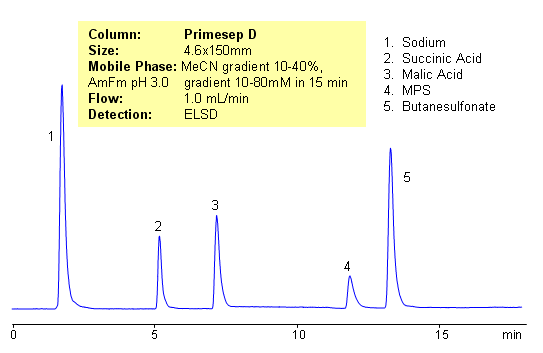
Primesep D mixed-mode column separates organic acids such as succinic acid, malic acid, MPS and butanesulfonate by a mixture of anion exchange and reversed phase mechanisms. Retention times can be changed by adjusting the percentage of acetonitrile in the mobile phase. This can not be done by traditional ion-exchange and ion-exclusion chromatography. The HPLC separation uses a mobile phase of water, acetonitrile (MeCN, ACN) and ammonium formate as a buffer, making the method MS-compatible. Can also use UV detection at 250 nm.
| Column | Primesep D, 4.6×150 mm, 5 µm, 100A |
| Mobile Phase | MeCN/H2O |
| Buffer | AmFm |
| Flow Rate | 1.0 ml/min |
| Detection | ELSD |
| Class of Compounds |
Acid, Hydrophilic, Ionizable |
| Analyzing Compounds | Sodium, Succinic Acid, Malic Acid, MPS, Butanesulfonate |
Application Column
Primesep D
The Primesep family of mixed-mode columns offers a wide variety of stationary phases, boasting unprecedented selectivity in the separation of a broad array of chemical compounds across multiple applications. Corresponding Primesep guard columns, available with all stationary phases, do not require holders. SIELC provides a method development service available to all customers. Inquire about our specially-tailored custom LC-phases for specific separations.
Select optionsMalic Acid
Organic Acids
Sodium
Succinic Acid
UV Detection

Simultaneous Analysis of Glucose, Sodium, Potassium and Calcium Ions
July 8, 2011
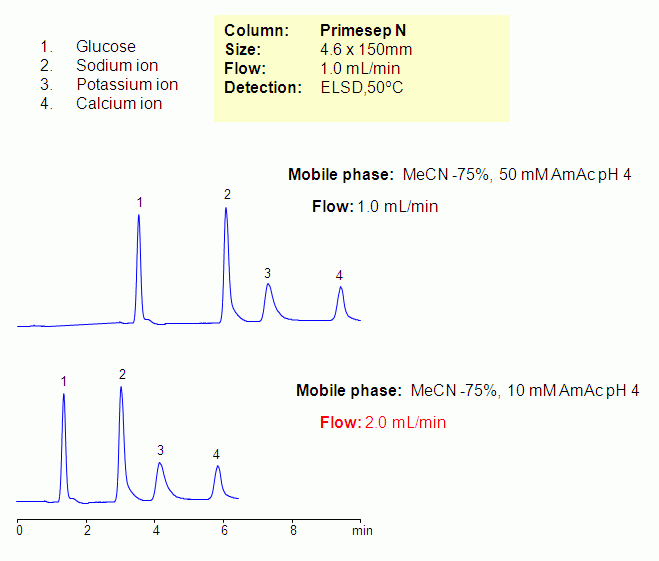
Neutral sugar, monovalent and divalent cations were separated in HILIC/cation-exchange mode on a Primesep N mixed-mode column. Mobile phase is compatible with LC/MS and method can be used for analysis polar molecules in HILIC, cation-exchange or anion-exclusion modes.
| Column | Primesep N, 4.6×150 mm, 5 µm, 100A |
| Mobile Phase | MeCN/H2O |
| Buffer | AmAc pH 4.0 |
| Flow Rate | 1.0 ml/min |
| Detection | ELSD 50C |
| Class of Compounds |
Ions, Hydrophilic, Ionizable |
| Analyzing Compounds | Potassium, Sodium, Calcium, Glucose |
Application Column
Primesep N
Column Diameter: 4.6 mm
Column Length: 150 mm
Particle Size: 5 µm
Pore Size: 100 A
Column options: dual ended
Glucose
Potassium
Sodium

Separation of Sodium, Tetramethylammonium and Tetrabutylammonium on Primesep 200 Column
July 7, 2011
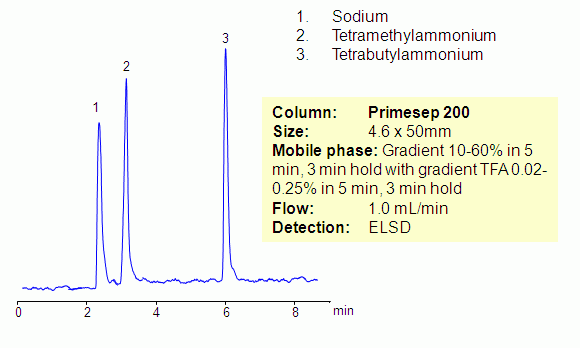
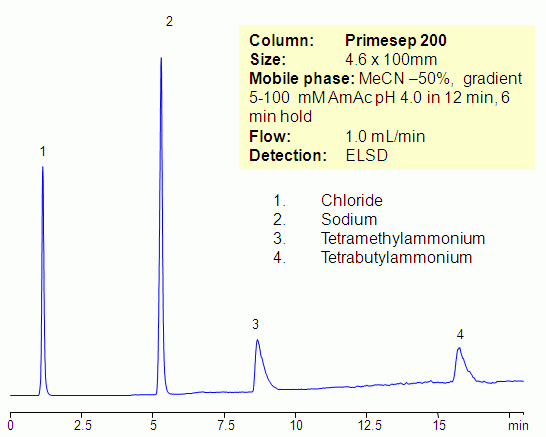
Hydrophilic and hydrophobic quaternary amines, along with sodium ion, were separated by mixed-mode chromatography on a Primesep 200 column. Mechanism of retention for sodium and tetramethylammonium ions is cation exchange, while the tetrabutylammonium ion is retained by combination of reversed-phase and cation-exchange mechanisms. All three compounds are not UV-active and monitoring is done by ELSD/CAD.
| Column | Primesep 200, 4.6×100 mm, 5 µm, 100A |
| Mobile Phase | MeCN/H2O |
| Buffer | AmAc pH4.0 |
| Flow Rate | 1.0 ml/min |
| Detection | ELSD |
| Class of Compounds |
Ions, Hydrophilic, Ionizable, Quaternary amines |
| Analyzing Compounds | Sodium, Chloride, Tetramethylammonium, Tetrabutylammonium |
Application Column
Primesep 200
The Primesep family of mixed-mode columns offers a wide variety of stationary phases, boasting unprecedented selectivity in the separation of a broad array of chemical compounds across multiple applications. Corresponding Primesep guard columns, available with all stationary phases, do not require holders. SIELC provides a method development service available to all customers. Inquire about our specially-tailored custom LC-phases for specific separations.
Select optionsTetrabutylammonium
Tetramethylammonium

HPLC Separation of Alkyl Sulfonic Acids
November 21, 2010
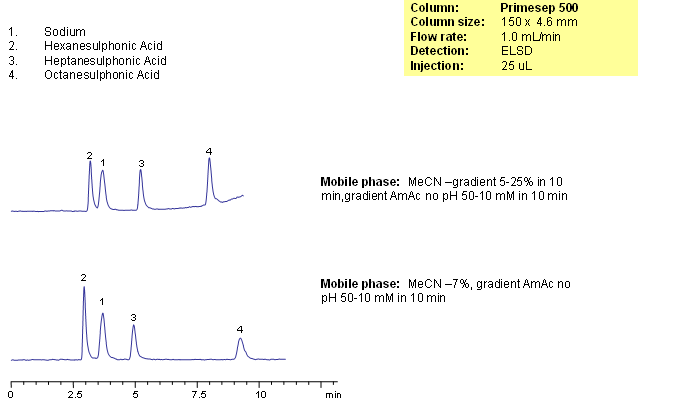
Alkyl sulphonic acids are used as surfactant additives in many products. Homologs of linear alkyl sulfonates are separated on a Primesep 500 mixed-mode cation exchange column in reversed-phase anion-exclusion mode. This generic method can be used for determination of alkyl sulfonates in detergents, soaps, etc.
| Column | Primesep 500, 4.6×150 mm, 5 µm, 100A |
| Mobile Phase | MeCN/H2O |
| Buffer | AmAc |
| Flow Rate | 1.0 ml/min |
| Detection | ELSD |
| Class of Compounds |
Acid, Hydrophilic, Ionizable |
| Analyzing Compounds | Sodium, Hexanesulphonic Acid, Heptanesulphonic Acid, Octanesulphonic Acid |
Application Column
Primesep 500
The Primesep family of mixed-mode columns offers a wide variety of stationary phases, boasting unprecedented selectivity in the separation of a broad array of chemical compounds across multiple applications. Corresponding Primesep guard columns, available with all stationary phases, do not require holders. SIELC provides a method development service available to all customers. Inquire about our specially-tailored custom LC-phases for specific separations.
Select optionsHexanesulfonic Acid
Octanesulfonic Acid
Sodium

HPLC Separation of Sodium, Chloride, Bromide, and Iodine
November 21, 2010
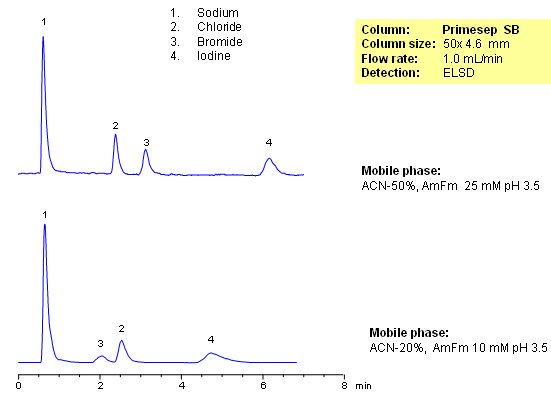
Halide ions are usually analyzed by ion-chromatography with a conductivity detector. Mixed-mode chromatography in combination with ELSD is offering a valuable alternative to ion-chromatography with conductivity detection. Chloride, bromide and iodide were separated on a Primesep SB mixed-mode anion-exchange column. Mobile phase is compatible with ELSD and LC/MS.
| Column | Primesep SB, 4.6×50 mm, 5 µm, 100A |
| Mobile Phase | MeCN/H2O |
| Buffer | AmFm |
| Flow Rate | 1.0 ml/min |
| Detection | ELSD |
| Class of Compounds |
Hydrophilic, Ions |
| Analyzing Compounds | Chloride, Sodium, Bromide, Iodine |
Application Column
Primesep SB
The Primesep family of mixed-mode columns offers a wide variety of stationary phases, boasting unprecedented selectivity in the separation of a broad array of chemical compounds across multiple applications. Corresponding Primesep guard columns, available with all stationary phases, do not require holders. SIELC provides a method development service available to all customers. Inquire about our specially-tailored custom LC-phases for specific separations.
Select optionsChloride
Iodine
Sodium

HPLC Separation of Sugar Phosphates
October 14, 2010
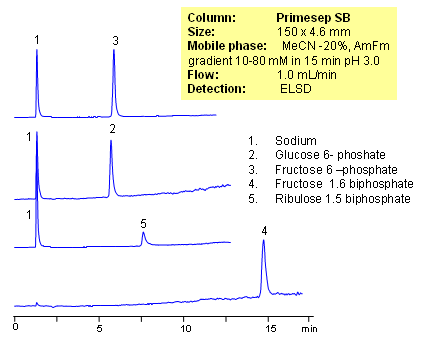
Sugar phosphates occur in biological systems. Sugar phosphates are parts of two metabolic pathways: glycolisis and pentose phosphate pathways. One of the purposes of sugar phosphates is to store and transfer energy in cells. Because of the presence of sugar fragment and phosphate moiety these molecules are very polar in nature. Mixed-mode chromatography was applied for separation of glucose and fructose phosphates and diphosphates. Compounds are separated based on anion-exchange properties with diphosphates retaining longer than mono phosphates. Monitoring is done by ELSD.
| Column | Primesep SB, 4.6×150 mm, 5 µm, 100A |
| Mobile Phase | MeCN/H2O – 20/80% |
| Buffer | AmFm – pH 3.0 |
| Flow Rate | 1.0 ml/min |
| Detection | ELSD |
| Class of Compounds |
Sugars |
| Analyzing Compounds | Sodium, Glucose 6- phosphate, Fructose 6 –phosphate, Fructose 1.6 biphosphate, Ribulose 1.5 biphosphate |
Application Column
Primesep SB
The Primesep family of mixed-mode columns offers a wide variety of stationary phases, boasting unprecedented selectivity in the separation of a broad array of chemical compounds across multiple applications. Corresponding Primesep guard columns, available with all stationary phases, do not require holders. SIELC provides a method development service available to all customers. Inquire about our specially-tailored custom LC-phases for specific separations.
Select optionsFructose 6-Phosphate
Glucose 6-Phosphate
Ribulose 1,5 Bisphosphate
Sodium

Simultaneous Determination of Sodium and Sulfate Ions on Obelisc N Mixed-mode HILIC Column
July 16, 2009
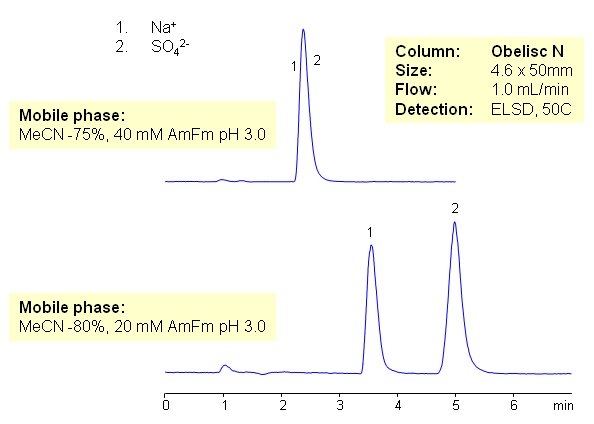
Inorganic cations and anions are usually analyzed by two different methods – cation-exchange and anion-exchange. This requires development and validation of two methods. Both ions can be analyzed on mixed-mode HILIC column with ELSD detection. Both ions are retained by combination of HILIC and ion-exchange mechanism.
| Column | Obelisc N, 4.6×50 mm, 5 µm, 100A |
| Mobile Phase | MeCN/H2O |
| Buffer | AmFm, pH 3.0 |
| Flow Rate | 1.0 ml/min |
| Detection | ELSD |
| Class of Compounds |
Acid, Hydrophilic, Ionizable |
| Analyzing Compounds | Sodium, Sulfate Ions |
Application Column
Obelisc N
SIELC has developed the Obelisc™ columns, which are mixed-mode and utilize Liquid Separation Cell technology (LiSC™). These cost-effective columns are the first of their kind to be commercially available and can replace multiple HPLC columns, including reversed-phase (RP), AQ-type reversed-phase, polar-embedded group RP columns, normal-phase, cation-exchange, anion-exchange, ion-exclusion, and HILIC (Hydrophilic Interaction Liquid Chromatography) columns. By controlling just three orthogonal method parameters - buffer concentration, buffer pH, and organic modifier concentration - users can adjust the column properties with pinpoint precision to separate complex mixtures.
Select optionsSulfate

HPLC Separation of Sulfate and Phosphate Ions on Mixed-Mode HPLC
December 6, 2007
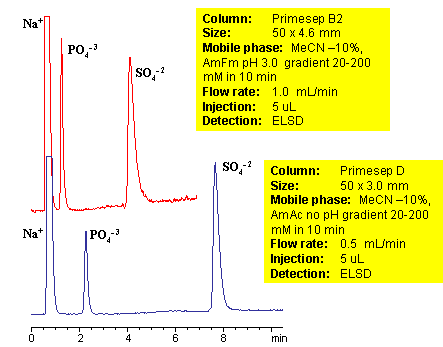
Sulfate and phosphate are separated on Primesep B2 and Primesep D column by anion-exchange mechanism. Because both sulfate and phosphate ions are not UV-active, ELSD is used to monitor separation of both anions. Method can be used to quantitate phosphate and sulfate in various pharmaceutical and chemical formulation, products and solution, drinking and ground water. Retention time is adjusted by increase or decrease of buffer concentrations. Two anions can be retained and separated on a very short column due to strong ion-exchange interaction. Method shows good reproducibility and versatility.
| Column | Primesep B2, 4.6×50 mm, 5 µm, 100A |
| Mobile Phase | MeCN/H2O |
| Buffer | AmFm pH 3.0 |
| Flow Rate | 1.0 ml/min |
| Detection | ELSD |
| Class of Compounds |
Ions, Hydrophilic, Ionizable, Vitamin, Supplements |
| Analyzing Compounds | Sodium, Phosphate, Sulfate |
Application Column
Primesep B2
The Primesep family of mixed-mode columns offers a wide variety of stationary phases, boasting unprecedented selectivity in the separation of a broad array of chemical compounds across multiple applications. Corresponding Primesep guard columns, available with all stationary phases, do not require holders. SIELC provides a method development service available to all customers. Inquire about our specially-tailored custom LC-phases for specific separations.
Select optionsPrimesep D
The Primesep family of mixed-mode columns offers a wide variety of stationary phases, boasting unprecedented selectivity in the separation of a broad array of chemical compounds across multiple applications. Corresponding Primesep guard columns, available with all stationary phases, do not require holders. SIELC provides a method development service available to all customers. Inquire about our specially-tailored custom LC-phases for specific separations.
Select optionsSodium
Sulfate

HPLC Separation of Citrulline and Arginine on Primesep 200 Column
November 21, 2006
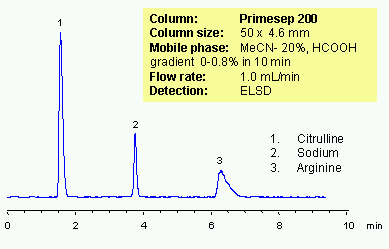
Citrulline and Arginine are α-amino acids that differ only in one functional group. They can be separated on a reverse-phase Primesep 200 HPLC column by hydrophobic and cation-exchange mechanisms in a mobile phase of water and acetonitrile (MeCN, ACN) with a gradient buffer of formic acid. Evaporative Light Scattering Detector (ELSD) used.
| Column | Primesep 200, 4.6×50 mm, 5 µm, 100A |
| Mobile Phase | MeCN/H2O |
| Buffer | Formic Acid |
| Flow Rate | 1.0 ml/min |
| Detection | ELSD |
| Class of Compounds |
Ions, Hydrophilic, Ionizable |
| Analyzing Compounds | Sodium, Citrulline, Arginine |
Application Column
Primesep 200
The Primesep family of mixed-mode columns offers a wide variety of stationary phases, boasting unprecedented selectivity in the separation of a broad array of chemical compounds across multiple applications. Corresponding Primesep guard columns, available with all stationary phases, do not require holders. SIELC provides a method development service available to all customers. Inquire about our specially-tailored custom LC-phases for specific separations.
Select optionsCitrulline
Sodium

Reverse Elution Order in Separation of Alkali Cation
August 12, 2006
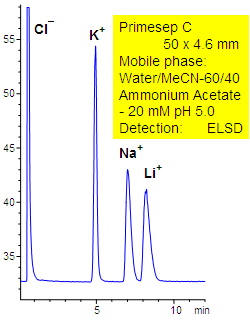
Primesep C separates a mixture of inorganic cations, potassium, sodium, and lithium, by a combination of cation exchange and complex formation. The peak order is reversed on the Primesep C column compared to the order normally obtained on columns that rely on cation exchange alone. The mobile phase mixture of water, acetonitrile (MeCN, ACN) and ammonium acetate is compatible with UV and evaporative light scattering detection (ELSD).
| Column | Primesep C, 4.6×50 mm, 5 µm, 100A |
| Mobile Phase | MeCN/H2O |
| Buffer | AmAc |
| Flow Rate | 1.0 ml/min |
| Detection | ELSD 50C |
| Class of Compounds |
Ions, Hydrophilic, Ionizable, Vitamin, Supplements |
| Analyzing Compounds | Sodium, Potassium, Lithium, Chloride |
Application Column
Primesep C
The Primesep family of mixed-mode columns offers a wide variety of stationary phases, boasting unprecedented selectivity in the separation of a broad array of chemical compounds across multiple applications. Corresponding Primesep guard columns, available with all stationary phases, do not require holders. SIELC provides a method development service available to all customers. Inquire about our specially-tailored custom LC-phases for specific separations.
Select optionsPotassium
Sodium

Effect of Concentration of Organic Modifier on Retention of Cation and Anions
November 20, 2005
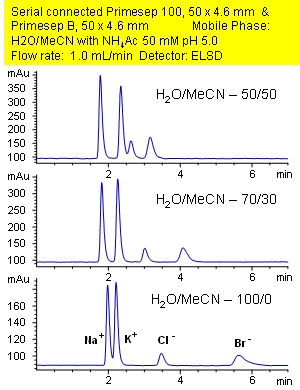
Primesep 100 and Primesep B columns connected in series allow the quantitation of sodium chloride and potassium bromide ions in one injection. The Primesep B column retains the chloride and bromide anions by anion exchange, and the Primesep 100 retains the sodium and potassium cations by cation exchange. The retention can be adjusted by changing the water/acetonitrile ratio in the mobile phase. The separation uses a mobile phase mixture of water, acetonitrile (MeCN, ACN) and ammonium acetate with evaporative light scattering detection (ELSD).
| Column | Primesep 100, Primesep B , 4.6×50 mm, 5 µm, 100A |
| Mobile Phase | MeCN/H2O |
| Buffer | AmAc pH 5.0 |
| Flow Rate | 1.0 ml/min |
| Detection | ELSD |
| Class of Compounds |
Ions, Hydrophilic, Ionizable, Vitamin, Supplements |
| Analyzing Compounds | Sodium, Potassium, Bromide, Chloride |
Application Column
Primesep 100
The Primesep family of mixed-mode columns offers a wide variety of stationary phases, boasting unprecedented selectivity in the separation of a broad array of chemical compounds across multiple applications. Corresponding Primesep guard columns, available with all stationary phases, do not require holders. SIELC provides a method development service available to all customers. Inquire about our specially-tailored custom LC-phases for specific separations.
Select optionsPrimesep B
The Primesep family of mixed-mode columns offers a wide variety of stationary phases, boasting unprecedented selectivity in the separation of a broad array of chemical compounds across multiple applications. Corresponding Primesep guard columns, available with all stationary phases, do not require holders. SIELC provides a method development service available to all customers. Inquire about our specially-tailored custom LC-phases for specific separations.
Select optionsChloride
Potassium
Sodium

Simultaneous Separation of Cations and Anions
November 15, 2005
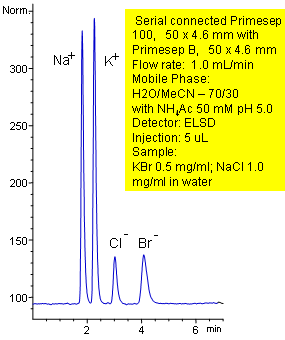
Primesep 100 and Primesep B columns connected in series allow the quantitation of sodium chloride and potassium bromide ions in one injection. The Primesep B column retains the chloride and bromide anions by anion exchange, and the Primesep 100 retains the sodium and potassium captions by cation exchange. The separation uses a mobile phase mixture of water, acetonitrile (MeCN, ACN) and trifluoroacetic acid (TFA) with evaporative light scattering detection (ELSD).
| Column | Primesep 100, Primesep B , 4.6×50 mm, 5 µm, 100A |
| Mobile Phase | MeCN/H2O |
| Buffer | AmAc pH 5.0 |
| Flow Rate | 1.0 ml/min |
| Detection | ELSD 50C |
| Class of Compounds |
Ions, Hydrophilic, Ionizable, Vitamin, Supplements |
| Analyzing Compounds | Sodium, Potassium, Bromide, Chloride |
Application Column
Primesep 100
The Primesep family of mixed-mode columns offers a wide variety of stationary phases, boasting unprecedented selectivity in the separation of a broad array of chemical compounds across multiple applications. Corresponding Primesep guard columns, available with all stationary phases, do not require holders. SIELC provides a method development service available to all customers. Inquire about our specially-tailored custom LC-phases for specific separations.
Select optionsPrimesep B
The Primesep family of mixed-mode columns offers a wide variety of stationary phases, boasting unprecedented selectivity in the separation of a broad array of chemical compounds across multiple applications. Corresponding Primesep guard columns, available with all stationary phases, do not require holders. SIELC provides a method development service available to all customers. Inquire about our specially-tailored custom LC-phases for specific separations.
Select optionsChloride
Potassium
Sodium

Complex of Cations on Primesep C is Effected by Organic Modifier
October 15, 2005
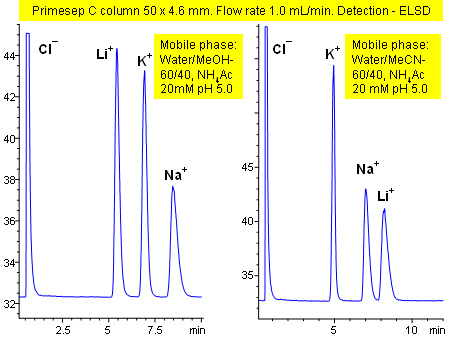
Primesep C separates a mixture of inorganic cations, potassium, sodium, and lithium, by a combination of cation exchange and complex formation. The peak order is reversed on the Primesep C column compared to the order normally obtained on columns that rely on cation exchange alone. In addition, the elution order can be rearranged by simply changing the organic modifier in the mobile phase from acetonitrile to methanol. The mobile phase mixture of water, acetonitrile (MeCN, ACN) or methanol (MeOH) and ammonium acetate is compatible with UV and evaporative light scattering detection (ELSD).
| Column | Primesep C, 4.6×50 mm, 5 µm, 100A |
| Mobile Phase | MeOH, MeCN |
| Buffer | AmAc pH 5.0 |
| Flow Rate | 1.0 ml/min |
| Detection | ELSD 50C |
| Class of Compounds |
Ions, Hydrophilic, Ionizable, Vitamin, Supplements |
| Analyzing Compounds | Sodium, Potassium, Lithium, Chloride |
Application Column
Primesep C
The Primesep family of mixed-mode columns offers a wide variety of stationary phases, boasting unprecedented selectivity in the separation of a broad array of chemical compounds across multiple applications. Corresponding Primesep guard columns, available with all stationary phases, do not require holders. SIELC provides a method development service available to all customers. Inquire about our specially-tailored custom LC-phases for specific separations.
Select optionsPotassium
Sodium

Zn and Na Quantitation in Drug Substances
October 11, 2005
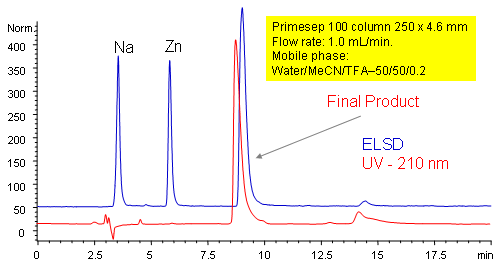
Primesep 100 allows the quantitation of sodium and zinc cations in a drug product sample. The cations are retained by cation exchange and the drug product is retained by hydrophobic, reversed-phase mechanisms. The separation uses a mobile phase mixture of water, acetonitrile (MeCN, ACN) and trifluoroacetic acid (TFA) with evaporative light scattering detection (ELSD) and UV detection.
| Column | Primesep 100, 4.6×250 mm, 5 µm, 100A |
| Mobile Phase | MeCN/H2O |
| Buffer | TFA |
| Flow Rate | 1.0 ml/min |
| Detection | ELSD 50C |
| Class of Compounds |
Ions, Hydrophilic, Ionizable, Vitamin, Supplements |
| Analyzing Compounds | Sodium, Zinc |
Application Column
Primesep 100
The Primesep family of mixed-mode columns offers a wide variety of stationary phases, boasting unprecedented selectivity in the separation of a broad array of chemical compounds across multiple applications. Corresponding Primesep guard columns, available with all stationary phases, do not require holders. SIELC provides a method development service available to all customers. Inquire about our specially-tailored custom LC-phases for specific separations.
Select optionsSodium
Zinc
UV Detection

Separation of Guanidine on Primesep 100 Column
October 4, 2005
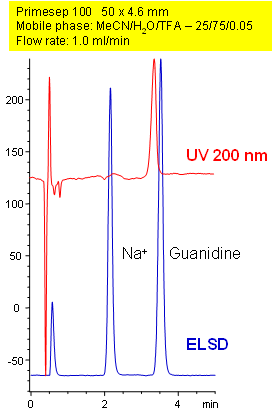
Primesep 100 separates guanidine from its sodium counterion on a short 50 mm column by cation exchange. Guanidine is found in urine as a product of protein metabolism and is also used in the manufacture of plastics and explosives. Guanidine is detected by UV detection at 200 nm, but UV cannot detect the sodium ion. If an evaporative light scattering detector (ELSD) is used, both components can be detected. The separation method uses a mobile phase mixture of water, acetonitrile (MeCN, ACN) and trifluoroacetic acid (TFA).
| Column | Primesep 100, 4.6×50 mm, 5 µm, 100A |
| Mobile Phase | MeCN/H2O |
| Buffer | TFA |
| Flow Rate | 1.0 ml/min |
| Detection | ELSD, UV 200nm |
| Class of Compounds |
Ions, Hydrophilic, Ionizable |
| Analyzing Compounds | Sodium, Guanidine |
Application Column
Primesep 100
The Primesep family of mixed-mode columns offers a wide variety of stationary phases, boasting unprecedented selectivity in the separation of a broad array of chemical compounds across multiple applications. Corresponding Primesep guard columns, available with all stationary phases, do not require holders. SIELC provides a method development service available to all customers. Inquire about our specially-tailored custom LC-phases for specific separations.
Select optionsSodium
UV Detection

HPLC ELSD Method for Separation of Metal Ions on Primesep 100 Column
October 4, 2005
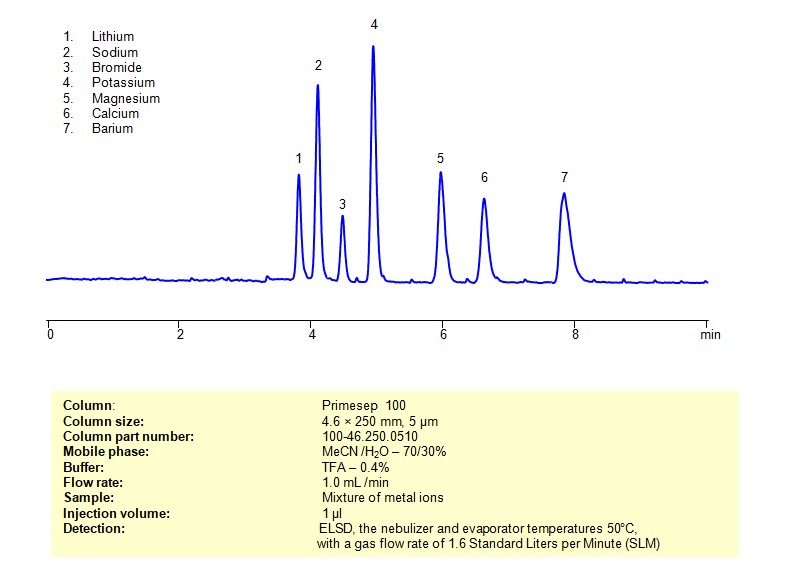
Primesep 100 separates the monovalent cations, lithium, potassium, and sodium, and the divalent cations, zinc, manganese, and calcium. The cations are resolved by cation exchange. The mobile phase mixture of water, acetonitrile (MeCN, ACN) and trifluoroacetic acid (TFA) is evaporative light scattering detection (ELSD) compatible.
| Column | Primesep 100, 4.6×250 mm, 5 µm, 100A |
| Mobile Phase | MeCN/H2O – 70/30% |
| Buffer | TFA- 0.4% |
| Flow Rate | 1.0 ml/min |
| Detection | ELSD 50C |
| Class of Compounds | Ions, Hydrophilic, Ionizable, Vitamin, Supplements |
| Analyzing Compounds | Sodium, Magnesium, Calcium, Lithium, Barium |
Application Column
Primesep 100
Column Diameter: 4.6 mm
Column Length: 250 mm
Particle Size: 5 µm
Pore Size: 100 A
Column options: dual ended
Bromide
Calcium
Lithium
Magnesium
Potassium
Sodium

HPLC Separation of Chloride and Nitrate Ions
January 13, 2005
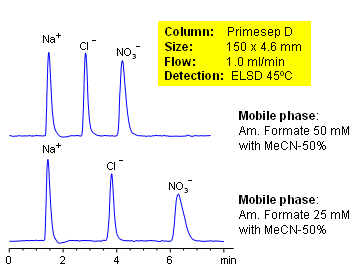
High nitrate concentrations in water and soil can be toxic to humans, fish and domestic animals. Chloride can be used for analysis of water contamination. Primesep D column can be used to separate and quantify both ions. The baseline separation between chloride and nitrate can be increased by decreasing the ammonium formate concentration in the mobile phase. Evaporative Light Scattering Detection (ELSD) used.
| Column | Primesep D, 4.6×150 mm, 5 µm, 100A |
| Mobile Phase | MeCN/H2O |
| Buffer | AmFm |
| Flow Rate | 1.0 ml/min |
| Detection | ELSD |
| Class of Compounds |
Hydrophilic, Ion |
| Analyzing Compounds | Chloride, Nitrate |
Application Column
Primesep D
The Primesep family of mixed-mode columns offers a wide variety of stationary phases, boasting unprecedented selectivity in the separation of a broad array of chemical compounds across multiple applications. Corresponding Primesep guard columns, available with all stationary phases, do not require holders. SIELC provides a method development service available to all customers. Inquire about our specially-tailored custom LC-phases for specific separations.
Select optionsNitrate
Nitric Acid
Sodium

